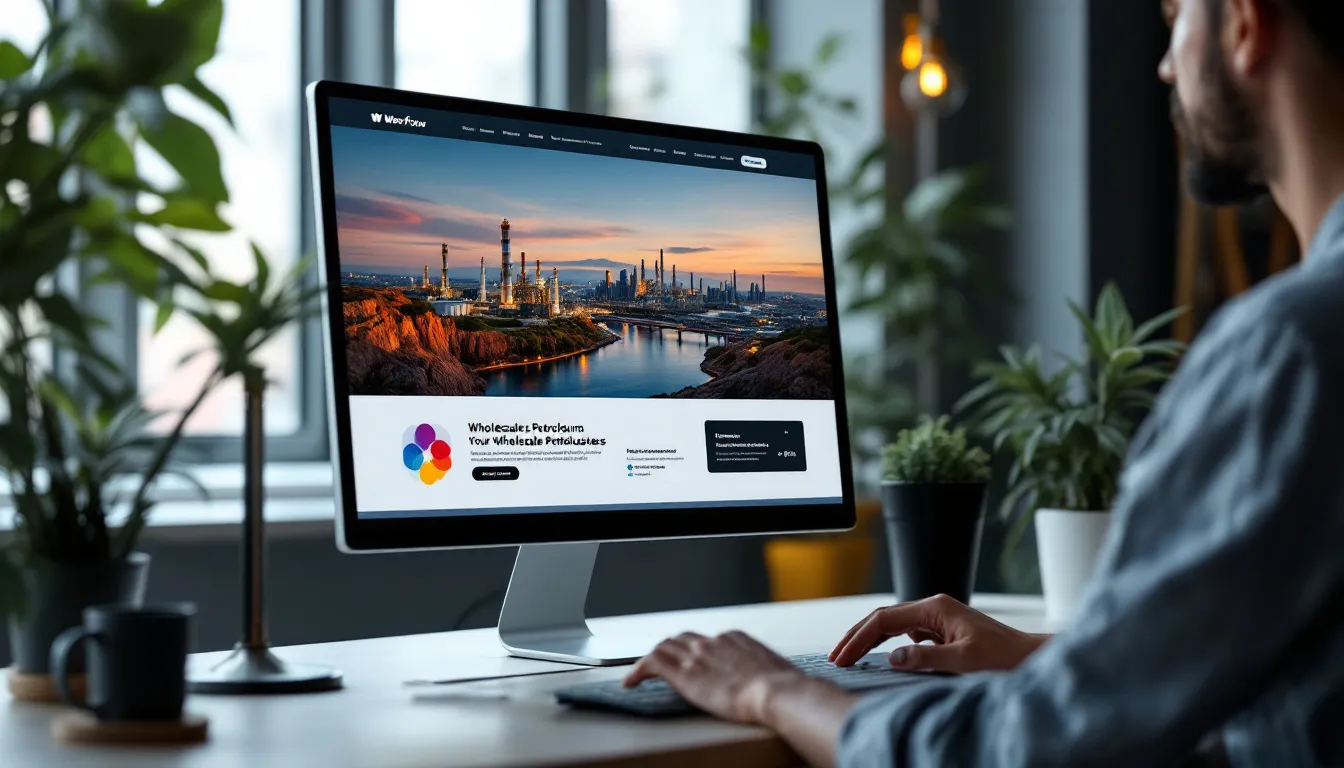See How I Helped My Client Achieve Better Results
A real-life case study of a website redesign on CMS — optimized for growth, easy content management, and stronger SEO performance.
- Custom Design That Reflects Your Brand Unlike cookie-cutter templates, Webflow offers full creative freedom. I design websites tailored to your specific goals, ensuring a professional look that resonates with your audience.
- Clean, SEO-Friendly StructureWebflow’s built-in SEO capabilities allow me to create a well-structured website with:
- Clean, keyword-rich URLs for better search visibility.
- Logical internal linking to boost user navigation and page authority.
- Schema markup integration for enhanced search engine understanding.
- Responsive by DesignYour audience is using desktops, tablets, and smartphones. Every site I build is optimized for all screen sizes, ensuring a seamless experience no matter how visitors access it.
- CMS That Puts You in ControlWith Webflow’s powerful CMS, you can easily manage and update your content, from blog posts to product descriptions, without needing technical expertise.
How to Build a Civil Engineering Company Website in Webflow with CMS: A Guide for Designers
Creating a website for a civil engineering company involves more than just aesthetics; it requires a thoughtful approach that encompasses user experience (UX), search engine optimization (SEO), and conversion rate optimization (CRO). Webflow, a powerful web design tool, allows designers to build visually stunning and functional websites while incorporating a content management system (CMS) that makes it easy to manage and update content. This guide will walk you through the essential steps to create a civil engineering company website in Webflow, ensuring it meets the needs of both the business and its clients.
Understanding the Basics of Webflow
Before diving into the specifics of building a website, it’s crucial to understand what Webflow is and how it can benefit a civil engineering company. Webflow is a web design platform that combines the flexibility of coding with the ease of a visual editor. This means designers can create responsive websites without needing extensive coding knowledge, making it accessible for many.

Why Choose Webflow?
Webflow stands out for several reasons. First, it offers a user-friendly interface that allows designers to create custom layouts and interactions. Second, its CMS capabilities enable easy content updates, which is essential for businesses that frequently showcase new projects or services. Finally, Webflow's hosting is optimized for performance, ensuring that the website loads quickly—a critical factor for both user experience and SEO.
Moreover, Webflow provides a unique blend of design freedom and functionality that is particularly appealing to civil engineering firms. The platform's ability to integrate with various third-party tools means that companies can enhance their websites with features like project management systems or customer relationship management (CRM) software. This integration capability allows for a seamless workflow, enabling teams to manage their online presence more effectively while focusing on their core engineering projects.
Key Features of Webflow for Civil Engineering Websites
When building a civil engineering company website, certain features are particularly beneficial. Webflow allows for custom animations and interactions that can make project showcases more engaging. Additionally, the platform supports responsive design, ensuring that the website looks great on all devices, from desktops to smartphones. Finally, Webflow’s built-in SEO tools help optimize the website for search engines, making it easier for potential clients to find the company online.
Furthermore, Webflow offers a robust e-commerce solution that can be particularly useful for civil engineering firms looking to sell products or services directly from their website. This feature can include selling project blueprints, consultation services, or even branded merchandise. The e-commerce capabilities are integrated seamlessly with the rest of the site, allowing for a cohesive user experience. Additionally, Webflow’s analytics tools provide insights into visitor behavior, helping firms understand which projects or services attract the most interest, thereby informing future marketing strategies and project development.
Planning Your Website Structure
A well-structured website is vital for providing a positive user experience. Before starting the design process, it’s essential to outline the main sections and pages of the website. For a civil engineering company, consider including the following key pages:
Homepage
The homepage serves as the first impression for visitors. It should clearly communicate the company’s services, showcase recent projects, and provide easy navigation to other sections of the site. A hero image or video of a notable project can capture attention immediately, while concise text can convey the company’s mission and values. Furthermore, integrating client testimonials or case studies can enhance the homepage by providing social proof and showcasing the company’s successful track record. This not only instills confidence in potential clients but also encourages them to explore further.
About Us Page
This page should detail the company’s history, mission, and team. Including bios and photos of key team members can help build trust and establish a personal connection with potential clients. Additionally, highlighting any certifications or awards can enhance credibility. It may also be beneficial to include a timeline of significant milestones in the company’s journey, illustrating growth and expertise over the years. This narrative can help visitors understand the company’s evolution and commitment to excellence in the civil engineering field.
Services Offered
Detailing the services offered is crucial for informing potential clients about what the company can do. Each service should have its own section or page, complete with descriptions, benefits, and relevant images. This not only helps with SEO but also ensures that visitors can easily find the information they need. To further engage visitors, consider incorporating interactive elements such as service comparison charts or FAQs that address common client concerns. This approach not only enhances user experience but also positions the company as an authority in the industry, demonstrating a thorough understanding of client needs and expectations.
Designing the Website in Webflow
With a solid plan in place, it’s time to start designing the website in Webflow. The platform provides various tools and features to create a visually appealing and functional site. Here are some key design considerations:
Choosing a Template or Starting from Scratch
Webflow offers a range of templates that can serve as a starting point. For a civil engineering company, look for templates that emphasize professionalism and clarity. Alternatively, starting from scratch allows for complete customization, ensuring the website aligns perfectly with the company’s branding and vision.
Creating a Responsive Design
Responsive design is essential in today’s digital landscape. Webflow makes it easy to create designs that adapt to different screen sizes. Utilize the platform’s breakpoints to adjust layouts, images, and text for optimal viewing on desktops, tablets, and smartphones. Testing the design on various devices during the development process can help identify any issues early on.
Integrating the CMS for Easy Content Management
One of the standout features of Webflow is its CMS, which allows for easy content management without requiring technical expertise. For a civil engineering company, the CMS can be particularly useful for managing project portfolios, blog posts, and service descriptions.

Setting Up Collections
Collections in Webflow are like databases that store content. For a civil engineering website, consider creating collections for projects, services, team members, and blog posts. This structure allows for easy updates and ensures that all content is organized and accessible.
Dynamic Content Display
Using the CMS, designers can create dynamic content displays that automatically pull in information from collections. For example, a project showcase page can display all projects in a visually appealing layout, updating automatically as new projects are added to the collection. This feature not only saves time but also keeps the website fresh and engaging.
Optimizing for SEO
SEO is crucial for ensuring that the civil engineering company’s website ranks well in search engine results. Webflow offers built-in SEO tools that can help optimize the site effectively. Here are some essential SEO practices to implement:

Keyword Research
Before optimizing the website, conducting keyword research is essential. Identify relevant keywords that potential clients might use when searching for civil engineering services. Incorporate these keywords naturally into page titles, headings, and content to improve visibility in search results.
Meta Tags and Descriptions
Webflow allows for easy editing of meta tags and descriptions for each page. Crafting compelling meta descriptions can improve click-through rates from search results. Ensure that each page has a unique meta description that accurately reflects the content and includes relevant keywords.
Enhancing User Experience (UX)
Creating a positive user experience is key to keeping visitors engaged and encouraging them to take action, whether that’s contacting the company or requesting a quote. Here are some UX best practices to consider:
Intuitive Navigation
Navigation should be straightforward and intuitive. Use clear labels for menu items and ensure that visitors can easily find what they’re looking for. Consider implementing a sticky navigation bar that remains visible as users scroll, making it easier to access different sections of the site.
Fast Loading Times
Website loading speed is a critical factor for both user experience and SEO. Webflow’s hosting is optimized for performance, but it’s still essential to optimize images and minimize the use of heavy scripts. Regularly testing the website’s loading speed can help identify any areas for improvement.
Implementing Conversion Rate Optimization (CRO)
Once the website is live, focusing on conversion rate optimization can help turn visitors into clients. Here are some strategies to improve conversions:
Clear Calls to Action (CTAs)
Every page should have a clear call to action that guides visitors toward the desired outcome, whether that’s filling out a contact form, requesting a quote, or signing up for a newsletter. Use contrasting colors and strategic placement to make CTAs stand out.
Testimonials and Case Studies
Including testimonials and case studies can significantly boost credibility and encourage potential clients to reach out. Showcase successful projects and client feedback prominently on the website. This not only builds trust but also demonstrates the company’s expertise and reliability.
Testing and Launching the Website
Before officially launching the website, thorough testing is essential. This includes checking for broken links, ensuring that all forms work correctly, and testing the site’s responsiveness on various devices. Gathering feedback from colleagues or potential users can provide valuable insights into any areas that may need improvement.
Monitoring Performance Post-Launch
Once the website is live, it’s important to monitor its performance. Use tools like Google Analytics to track visitor behavior, page views, and conversion rates. Analyzing this data can help identify trends and areas for improvement, allowing for ongoing optimization.
Conclusion
Building a civil engineering company website in Webflow with CMS capabilities is an excellent way to create a professional online presence that is easy to manage and update. By focusing on UX, SEO, and CRO, designers can ensure that the website not only looks great but also serves its purpose effectively. With careful planning, attention to detail, and a commitment to continuous improvement, the website can become a valuable asset for the civil engineering company, helping to attract new clients and showcase its expertise.
Ready to Elevate Your Civil Engineering Firm's Online Presence?
If you're inspired to build a high-performance, SEO-optimized website that converts visitors into clients, look no further. I am Karina Slizova, a Freelance Web Designer and Webflow Developer with a passion for crafting tailored no-code website solutions for industries like Construction, Architecture, and more. Together, we can create a website that not only looks exceptional but also aligns seamlessly with your business objectives. Schedule a call with me today, and let's turn your vision into a digital reality that stands out in your field.

👋 I'm Karina Slizova — a Webflow designer and developer specializing in websites for construction, agriculture, real estate, and architecture companies.
If you're looking to build a website like this and hire a Webflow designer — let's talk.







